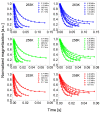Water Dynamics in Highly Concentrated Protein Systems-Insight from Nuclear Magnetic Resonance Relaxometry
- PMID: 36835511
- PMCID: PMC9963861
- DOI: 10.3390/ijms24044093
Water Dynamics in Highly Concentrated Protein Systems-Insight from Nuclear Magnetic Resonance Relaxometry
Abstract
1H spin-lattice relaxation experiments have been performed for water-Bovine Serum Albumin (BSA) mixtures, including 20%wt and 40%wt of BSA. The experiments have been carried out in a frequency range encompassing three orders of magnitude, from 10 kHz to 10 MHz, versus temperature. The relaxation data have been thoroughly analyzed in terms of several relaxation models with the purpose of revealing the mechanisms of water motion. For this purpose, four relaxation models have been used: the data have been decomposed into relaxation contributions expressed in terms of Lorentzian spectral densities, then three-dimensional translation diffusion has been assumed, next two-dimensional surface diffusion has been considered, and eventually, a model of surface diffusion mediated by acts of adsorption to the surface has been employed. In this way, it has been demonstrated that the last concept is the most plausible. Parameters describing the dynamics in a quantitative manner have been determined and discussed.
Keywords: dynamics; proteins; relaxation.
Conflict of interest statement
The authors declare no conflict of interest.
Figures














Similar articles
-
Slow dynamics of solid proteins - Nuclear magnetic resonance relaxometry versus dielectric spectroscopy.J Magn Reson. 2020 May;314:106721. doi: 10.1016/j.jmr.2020.106721. Epub 2020 Mar 19. J Magn Reson. 2020. PMID: 32276108
-
Water molecule contributions to proton spin-lattice relaxation in rotationally immobilized proteins.J Magn Reson. 2009 Jul;199(1):68-74. doi: 10.1016/j.jmr.2009.04.001. Epub 2009 Apr 8. J Magn Reson. 2009. PMID: 19394883 Free PMC article.
-
Mechanism of Water Dynamics in Hyaluronic Dermal Fillers Revealed by Nuclear Magnetic Resonance Relaxometry.Chemphyschem. 2019 Nov 5;20(21):2816-2822. doi: 10.1002/cphc.201900761. Epub 2019 Oct 17. Chemphyschem. 2019. PMID: 31532873 Free PMC article.
-
Self-diffusion studies by intra- and inter-molecular spin-lattice relaxometry using field-cycling: Liquids, plastic crystals, porous media, and polymer segments.Prog Nucl Magn Reson Spectrosc. 2017 Aug;101:18-50. doi: 10.1016/j.pnmrs.2017.04.001. Epub 2017 Apr 9. Prog Nucl Magn Reson Spectrosc. 2017. PMID: 28844220 Review.
-
Overhauser Dynamic Nuclear Polarization for the Study of Hydration Dynamics, Explained.Methods Enzymol. 2019;615:131-175. doi: 10.1016/bs.mie.2018.09.024. Epub 2018 Dec 11. Methods Enzymol. 2019. PMID: 30638529 Review.
Cited by
-
Markers of low field NMR relaxation features of tissues.Sci Rep. 2024 Oct 22;14(1):24901. doi: 10.1038/s41598-024-74055-7. Sci Rep. 2024. PMID: 39438494 Free PMC article.
-
Dynamics of Supramolecular Ionic Gels by Means of Nuclear Magnetic Resonance Relaxometry-The Case of [BMIM][Cl]/Propylene Carbonate Gel.Molecules. 2025 Jun 15;30(12):2598. doi: 10.3390/molecules30122598. Molecules. 2025. PMID: 40572561 Free PMC article.
-
Multi-mode water dynamics in hydration shells of villin headpiece subdomain protein in the solid state using deuterium and oxygen-17 NMR spectroscopy.J Chem Phys. 2025 Jul 14;163(2):025101. doi: 10.1063/5.0279081. J Chem Phys. 2025. PMID: 40642973 Free PMC article.
-
Diffusion of Water Molecules on the Surface of Silica Nanoparticles─Insights from Nuclear Magnetic Resonance Relaxometry.J Phys Chem B. 2024 Feb 15;128(6):1535-1543. doi: 10.1021/acs.jpcb.3c06451. Epub 2024 Jan 31. J Phys Chem B. 2024. PMID: 38295281 Free PMC article.
References
-
- Slichter C.P. Principles of Magnetic Resonance. 3rd ed. Springer; Berlin, Germany: 1990.
-
- Kruk D. Understanding Spin Dynamics. CRC Press–Pan Stanford Publishing; Boca Raton, FL, USA: 2015.
-
- Kowalewski J., Maler L. Nuclear Spin Relaxation in Liquids: Theory, Experiments, and Applications. 2nd ed. CRC Press–Taylor & Francis Group; Boca Raton, FL, USA: 2019.
MeSH terms
Substances
Grants and funding
LinkOut - more resources
Full Text Sources
Medical

